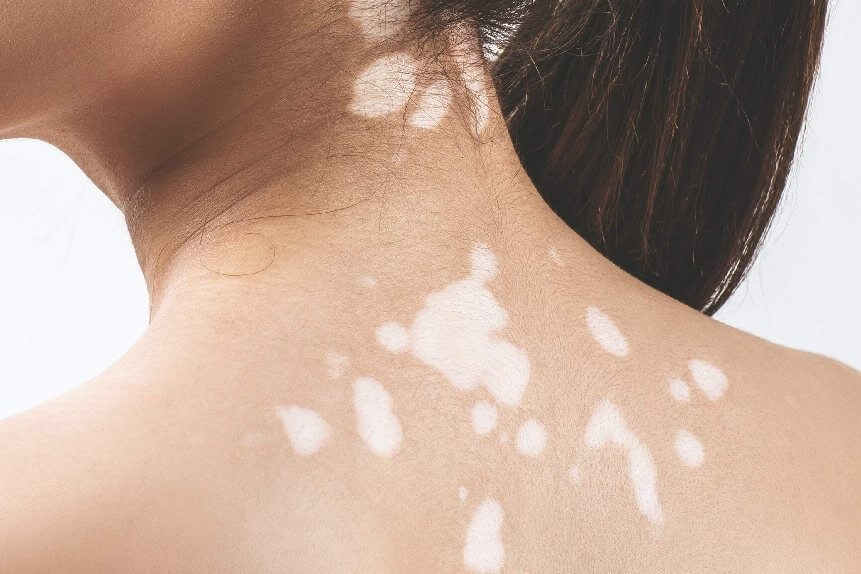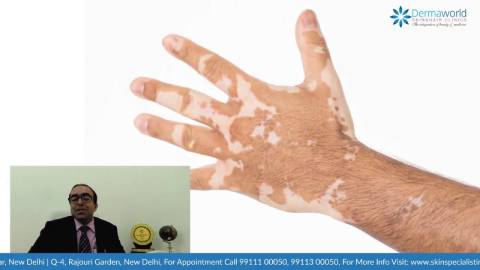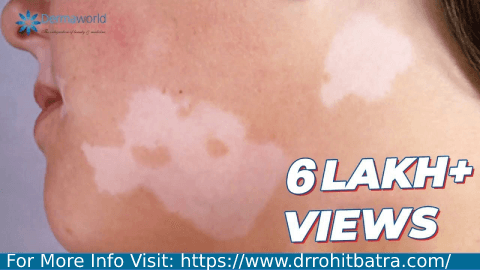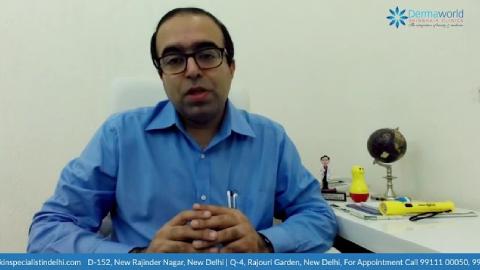
The candidates affected by vitiligo must take the following precautions:
- The main goal is to protect the depigmented skin from sunburn, so sunscreen with SPF 30 or more must be applied.
- Avoid scrubbing or itching the patches as any kind of trauma can spread the patches further.
- Intake of a balanced diet is required to minimize oxidative stress.
- Other stress-busting activities such as exercising, yoga, and mediation will also be beneficial.
Best Vitiligo Specialist in Delhi
Vitiligo / White Patches is the most common dermatological disorder, in which hypo-pigmented, white patches or macules appear on the skin (skin loses its natural color). This condition affects 2% of the total population of the world. This skin disorder causes white patches on the skin. Under this kind of pigmentation disorder, cells that make pigment (melanocytes) in the skin are destroyed. As a result, white patches start appearing on the skin in different parts of the body. The vitiligo patches can appear on any part of the body and the most common areas affected by vitiligo are inside the mouth, around the nose, rectal areas, and nostrils. The same patches also appear on the mucous membranes (tissues that line the inner part of the mouth and nose) as well as the retina (inner layer of the eyeball).
Dr. Rohit Batra’s DermaWorld Skin Institute is one of the vitiligo specialist clinic in Delhi, where advanced treatment for managing vitiligo is offered by experts. Though vitiligo is not as harmful as other life-threatening diseases but can affect one appearance and confidence. Sometimes, people get white patches on the areas of the skin which are exposed to the sun. The condition can affect anyone regardless of race, gender, and age, it is more noticeable in people with dark skin.
Facts About Vitiligo:
There are many myths and confusion around vitiligo, and many people who are suffering from the disease are stigmatized. These facts will help one understand the condition more clearly.
- Vitiligo is not contagious and does not spread by direct contact, but it is a lifelong health condition.
- This skin disorder happens to anyone regardless of gender, age, or ethnicity.
- The cause of Vitiligo is still not known, but some researches point to the autoimmune disorder to be the cause of this problem.
- The common treatment options that are applied for severe cases are – exposure to UVA or UVB lights.
- Vitiligo is different from Albinism, a skin disease where people are born with white patches on the skin because they have melanin cells that do not produce pigment. Whereas people suffering from Vitiligo have working melanin cells that stop producing pigment in the future.
This undesirable skin condition can result in significant negative psychological effects and makes the affected individual embarrassed and ashamed of their appearance. It has been observed that a large number of patients with vitiligo are also dealing with depression. Consulting a vitiligo specialist in Delhi at DermaWorld Skin Institute can help one to get a smooth-looking skin texture as they can help one with the treatment and counseling to overcome the problems caused due to vitiligo.
Book An Appointment
ALL CLINICS CLOSED ON SUNDAY
What causes Vitiligo?
- 1The white patches (spots) occur due to the following reasons: - Vitiligo happens when the melanin-producing cells stop working, resulting in the discoloration of the skin. Though the definite cause of the skin disorder is unknown, some factors are involved in affecting the work of melanocytes.
- 2Immune System - When there are some changes happen in the immune system, it can trigger issues like vitiligo. The gene variations that influence the work of the immune system or melanocytes have roles to play in causing vitiligo. When the variations attack the immune systems and melanocytes mistakenly, white patches occur.
- 3Heredity - The disease can be passed down from affected parents to progeny and family members.
- 4Autoimmune Diseases - Acquired autoimmune destruction of melanocytes is one of the reasons. It mostly occurs in the areas where there is greater pigmentation such as the face and hands (mostly exposed to sunlight). As a result of the destruction of melanocytes, there is no melanin production and the skin color becomes lighter (white). Some autoimmune diseases such as hyperthyroidism, alopecia areata, and pernicious anemia can cause this problem.
- 5Other causes of this problem are: The other reasons are genetics, sunburn, stress, and exposure to certain harmful industrial chemicals.
TYPES OF VITILIGO:
1) Non-segmental vitiligo:
In this type of vitiligo, the patches are spread all over the body and are present in the body in a symmetrical pattern. This type of vitiligo progresses life-long. The common areas where this type of vitiligo appears on the back of the hands, arms, eyes, knees, elbows, feet, mouth, and nose. It is the most common type of vitiligo and can be further categorized into the following types based on the area where depigmentation occurs:
1.1 Generalized: Appears in the form of symmetrical patches on both sides of the body.
1.2 Universal: This is a very rare form of vitiligo that covers up to 80% of the body.
1.3 Focal: Again a rare type of vitiligo in which only a single patch or a few patches appear on the body. In some cases, it can be an early form of generalized vitiligo. It is easier to treat focal vitiligo than generalized vitiligo. It often occurs in young children.
1.4 Acrofacial: Affects the fingers or toes.
1.5 Mucosal: Affects the area around mucous membranes and lips.
2) Segmental vitiligo
In this type, the patches are present on one side of the body, and it is the least common type. It occurs at an early age and expands for a few years.
Vitiligo signs and symptoms:
Premature whitening and graying of the hair present on the eyelashes, beard, and hair.
Loss of skin color in patches.
Vitiligo Treatment in Delhi
There is no complete cure for such skin disorder, but some specific treatments can help to improve this skin condition. A dermatologist or a vitiligo specialist will advise a suitable treatment as different types of vitiligo require different treatments. The diagnosis is made with the use of a special lamp to shine ultraviolet light onto the skin to determine vitiligo.
Different types of vitiligo need a specific treatment that aims at treating the reason for the problem. Combinations of treatments can also help the skin to return to its color that has been lightened because of vitiligo.
The treatment measures for vitiligo management offered by vitiligo treatment doctor in Delhi, Dr. Rohit Batra:
1) Medications and creams:
Certain topical and corticosteroid creams can help the affected skin color to return by boosting the immune system and controlling the inflammation. The topical treatment is effective, easy to use, and improves the appearance of discoloration. They also help to start pigmenting the cells that improve the appearance of the discoloration. This treatment method is preferred for a small discolored area. The results are even visible when these creams are applied in combination with the ultraviolet lights.
2) Narrowband-UVB light
It is also known as phototherapy, and it is an efficient method in vitiligo treatment. It is a gold standard treatment for generalized vitiligo in both adults and children. This can be safely used for pregnant ladies or lactating mothers. The treatment takes 12 months to show results and sessions are performed twice or thrice a week.
3) Excimer Laser
If cells that stop producing pigments are stimulated in the right way, they can start producing pigment and treat vitiligo efficiently. The excimer laser uses the noble gas and reactive gas together which enhances the treatment. 308-nm excimer laser in an effective modality will treat the discoloration problem and stimulate the cells to produce pigment. This treatment is quite effective in treating facial vitiligo. Within the first 4 weeks, a dermatologist can suggest whether it’s working for the patient or not. Generally, up to 65% of improvement can be seen within 12-14 months of the treatment.
4) Surgery
When light therapy fails to work, then surgeries are recommended. There are a few options that prove to be very effective for treating vitiligo. Some of them are mentioned below.
Suction Blister: A blister is created on the normal skin by using suction. The top section of blister is used and they are removing and transplant on the discolored portion.
Grafting: The depigmented skin is replaced with new skin that can produce the pigment. This treatment helps treat small white patches. Blister grading is also a useful technique that uses a suction process over the discolored skin.
Tattooing: It is done using a special surgical instrument, and is usually performed around the lip area and in people who are having darker pigmentation.
Drugs: The melanocytes producing drugs are implanted under the skin to promote the growth of melanocytes. Various other drugs are applied in the form of a gel to treat localized vitiligo.
Melanocytes: In the procedure, the melanocytes and keratinocytes (the cells of the outermost layer of the skin) are implanted on the discolored area. First, these cells are cultured in a lab overnight and then placed surgically on the affected area. It has a high success rate of as much as 95%.
Who is the best candidate for these treatments?
People who have white blotches on their skin can take help from the vitiligo treatment. The treatment can help to improve the condition of the skin. In most cases, the treatment is effective to start re-pigmenting in the cells. Dr. Rohit Batra checks the medical history of the patients suffering from vitiligo and examines whether they have thyroid or autoimmune conditions or not. Then treatments and medications are prescribed accordingly based on the type of vitiligo to be managed.
Every individual body gives different responses to different treatments. When laser therapy works well on some, melanocyte proves very effective in some cases. So, treatment procedure varies to individuals, and so is the result.
Duration of the treatment:
The duration of the treatment depends on the individuals and their degree of problems. Some people get results within 3 to 6 months, whereas some do not see results even in 8 months. To have a good result, at least for 1-2 years one must take regular treatments.
Aftercare after vitiligo treatment
- Apply cream and ointment on the affected areas as per the direction of the doctor.
- Take extra care while applying creams around the eyes, mouth, and nose.
- For light therapy, the skin area that is exposed to special lights needs careful attention and proper care.
- Patients need to understand the nature and unpredictable course of this disease. A well-balanced nutritious diet with the right quantity and quality of vitamins and minerals is essential. Avoid emotional stress, physical & chemical damage to the skin and excessive use of Vitamin C.
The individual affected with vitiligo are at higher risk of developing:
- Eye problems (iris inflammation).
- Skin cancer.
- Psychological distress.
- Sunburn.
So, do not forget to protect skin from the sun. Use sunscreen, wide brims hats, sunglasses, and clothing that covers the exposed areas. To know White Patches/Spots Treatment Cost in Delhi, please feel free to connect.
Frequently Asked Questions
Vitiligo is a skin disorder in which the melanocytes cells that give color to the skin get destroyed or damaged. Melanocytes are responsible for producing melanin in the skin, which is a pigment that gives color to skin and hair. As melanocytes get damaged, so there is no melanin production in the skin resulting in the development of white patches on the skin. The vitiligo skin tissue is photosensitive, and the person who is affected by this condition, their skin becomes more sensitive to sunlight and is more prone to get damaged by the UV rays.
The primary and only symptom of vitiligo is the appearance of white patches on the skin. These patches can be smaller or larger depending upon the following patterns:
1. Segmental or focal vitiligo: In this condition, small white spots appear in one or a few areas of the body.
2. Non-segmental or generalized vitiligo: In these conditions, white patches appear on both sides of the body. It usually starts and stops several times throughout a person's lifetime.
The other symptoms of vitiligo include:
- Loss of color of the eyeball.
- Loss of color in the tissues that are present inside the mouth and nose..
- Premature graying or whitening of the hair on eyelashes, eyebrows, scalp or beard
Researchers are still trying to find the exact cause of vitiligo, but it is supposed that it is an autoimmune disorder in which the immune system of the body starts attacking the healthy melanocytes of the body resulting in the appearance of white patches on the skin. Various other factors like stress, pollution, UV rays, anxiety, genes, thyroid disease, are also considered as the causative factor for vitiligo.
Though there is no complete cure of vitiligo, still there are ways to manage its symptoms that include:
- Apply sunscreen and wear full clothing before going outside as protecting the skin will help in preventing the skin from harmful sun rays that can make the conditions worse.
- An individual suffering from vitiligo should pay special attention to their nutritional needs as it is an autoimmune disorder, so the immune system is benefited by the food that contains phytochemicals and antioxidants such as leafy greens, banana, apples, figs, and dates.
- An individual having vitiligo should avoid consuming alcohol and smoking, as these products can worsen the vitiligo condition.
- Consulting a dermatologist is a must before trying any home remedies.
Depending upon the severity of vitiligo, the dermatologist will suggest medications and other treatments to manage the symptoms of the condition. Dr. Rohit Batra, the best skin doctor, provides different treatments for vitiligo:
Medications and creams: Certain topical creams can help the affected skin to get its normal color and help to improve the appearance of discoloration.
Narrowband-UVB light: This is a phototherapy treatment that can be done in both adults and children to treat vitiligo condition.
Excimer Laser: This is an advanced technique to treat facial vitiligo, which gives approx 65% improvement within 12-14 months of the treatment.
Surgery: Grafting is also an effective way to restore the lost pigmentation in the white patches of the skin.
Yes, in 90% of the cases, vitiligo is considered as a hereditary disease. There is a probability that if parents have vitiligo, there are more possibilities to pass this condition to children through genes.
Though vitiligo can start at any age, it is more seen in persons in the age group of 20 and 30. In the initial phase, white patches begin on the face, then above the neck, on the eyes, elbows, hands, and then spreads to other parts of the body. Initially, these symptoms appear on one side of the body, but after some time, it starts spreading on different parts of the body.




